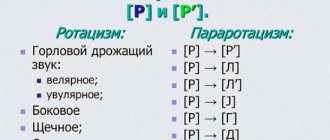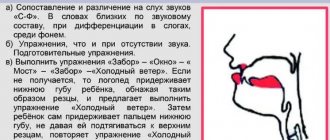How to make the sound "r"
An experienced speech therapist knows how to make the sound “r” for dysarthria, how to make the process of automating the sound “r” interesting. Making the sound “r” with dysarthria can take a long time. After warming up, the doctor asks the child to memorize the words, then repeat them using pictures. The pictures depict objects, flowers, plants, animals whose names contain the sound “r”. Such activities train memory and correct sound pronunciation. Methods used to make the sound “r”:
- Imitation.
- Through articulation.
- Mechanical assistance: from the reference sound, from the articulatory structure.
How to normally pronounce L
In many ways, the articulation of L and L is similar, so if a child’s speech has one of these sounds, then it will be easier to produce the other. When pronouncing the soft version, the lips are in a smile and the teeth are slightly open. The tip of the tongue is raised slightly higher than necessary to pronounce L and rests on the dental alveoli.
The rest of the tongue is not only raised, but also pushed forward. This softens the sound. The air stream exits through the gap formed between the teeth and the lateral edges of the tongue. The vocal cords are working, so L is sonorous.
Staging hissing sounds
Training takes place through classes; methods for producing hissing sounds depend on the diagnosis and the level of psychomotor dysfunction. The principle of an individual approach is used; classes should develop the child emotionally and intellectually. During the production of sounds, visual, auditory and tactile analyzers are connected, motor-kinesthetic, auditory-visual-kinesthetic, and didactic methods are used. Active and passive articulatory gymnastics and massage are performed.
Pathology options
The distorted pronunciation of L is called lambdacism. The cause of this disorder is the incorrect position of the articulation organs during sound pronunciation. In addition, there may be substitutions of one phoneme for another - paralambdacisms. Most often, the child chooses a sound with simpler articulation. Also, L may simply be absent in speech - the baby does not distort or replace it with another phoneme.
Types of lambdacisms:
- bilabial - in speech one hears Yu instead of L due to the fact that the tongue is not raised and the child pronounces the sound using the lips;
- nasal - during articulation, the tongue touches the soft palate, so part of the air stream passes through the nose, this adds a nasal sound;
- interdental - the tip of the tongue passes between the teeth.
Types of paralambdacisms:
- replacement with iotated vowels (Ё, E, Yu, I);
- on Vy.
Most often there are replacements from L to L, because the articulation of the latter is simpler. But sometimes there is a violation of the pronunciation of soft sounds. Properly selected exercises help correct this defect.
Individual lessons in difficult cases
It is more logical to give preference to individual lessons in difficult cases when the pronunciation of vowel sounds is impaired (for example, in hearing-impaired and deaf children or with rhinolalia, dysarthria). To do this, the teacher has various ways of posing problem sounds in his arsenal.
For example, to eliminate Y-shaped articulation, in addition to imitative exercises, a mechanical method, when the speech therapist presses the back of the tongue with a spatula, has a good effect. The same method is also suitable for narrowing the articulation of vowels O, U.
If a child has anterior articulation of sounds, this can be eliminated mechanically as follows: press the front part of the tongue with a spatula and push it back.
To close the passage into the nasal cavity and eliminate nasal tint, lightly press the root of the tongue with a spatula.
The sound A is usually placed by imitation, in the game. For example, a child is given a doll and asked to show how to rock it: ah-ah.
The sound O is well placed mechanically, starting from A. The speech therapist asks the child to pronounce the sound A, and in the meantime he brings the child’s lips together, giving them a rounded shape. You can also use various rings or bagels.
A speech therapist performs similar actions when setting the U. Only now here you need to build on the set O and bring the child’s lips even closer together.
The sound E. It is placed by imitation, starting from the vowel A in comparison.
When setting the Y, you can build on the articulation of the I. A spatula is used, because The oral gap is narrow when pronouncing the phoneme I. The speech therapist should press slightly with a spatula on the anterior lobe of the tongue and move it slightly deeper into the mouth. You need to invite the child to compare the sound of the sounds I-Y in syllables. For example, Pi - Py. It is also necessary to control the position of the lower jaw - it should not move forward.
Speech therapy diagnostics
Before starting to work with a preschooler, a speech therapist conducts diagnostics to determine the speech disorder and the mechanisms of the disorder. He checks the condition of the motor sphere. Particular attention is paid to the articulatory apparatus: its anatomical features and motor skills. The child is asked to perform static and dynamic exercises.
The specialist also checks the sound-pronunciation side of speech. Diagnostics includes checking:
- pronunciation of all phonemes;
- tempo-rhythmic component;
- syllable structure.
The speech therapist begins to check sounds with isolated pronunciation, then in syllables and words. The specialist also pays attention to how the baby pronounces phonemes in normal speech. Then the speech therapist looks at the formation of phonetic-phonemic processes. Checking this block includes:
- assessment of phonemic hearing (recognition and discrimination of sound in the speech stream);
- formation of sound-letter analysis;
- working with paronymous words.
The speech therapist necessarily checks the impressive and expressive vocabulary - speech understanding, vocabulary and how he uses it in his speech. Then the formation of grammatical structure and coherent speech.
The speech therapist selects speech material for diagnosis in accordance with the child’s age. Also, parents should not worry too much if a child at the age of 3 cannot pronounce the sound L. The sonorous group is formed closer to 4-5 years, but it is worth paying special attention to the rise of the tongue.
Timely speech therapy diagnostics will identify possible problems that may cause distortion of sound pronunciation. The speech therapist will select exercises that prepare the organs of articulation for pronouncing the sound L.
Technique for setting vowel sounds
Among the most common methods for producing vowel sounds is the method of F.F. Rau, N.F. Slezina and the methodology of K.A. Volkova.
The first of them provides:
- Pronounce the vowel for a long time as part of syllables and in isolation.
- Practice the vowel in syllables and in isolation, abruptly, briefly.
- Change the volume of the sound when pronouncing it.
- Pronounce the vowel phoneme, placing stress on it, as well as unstressed syllables and words.
- Distinguishing vowels in syllables.
K.A. Volkova suggests performing the following types of exercises:
- Speak the sound in isolation.
- Pronounce a vowel with tension in the articulatory organs: positions under stress; and at the beginning of a word; at the beginning of a syllable.
- Practice under stress and in an unstressed position.
- Pronounce at the beginning of a word, syllable, at the end, between consonants, i.e. change the position of the sound.
- Distinguish vowels in syllables and words.
Automation of the J sound in words:
For automation in words, you can use speech material that contains the sound Y, as well as those words that contain the letters Y-Y-Y-E, etc.
There are quite a lot of such words: [YA] - Pit, pit, sneak, java, turnout, berry, poison, tongue, core, yakut, yak, anchor, skiff, manger, testicle, egg, coachman, yacht, yacht, box, January , amber, fair, apple, apple tree, hawk, lamb, Yana, bright, clear, ash, Yasha, Jacob, Jadwiga, barley, jasper, lizards, tier, Paradise, Zoya, May, soybean, fairy, lighthouse, milkmaid, button accordion , mine, solder, belt, pendulum, piano, flock, thuja, yours, needles, Tatyana, Agafya, seamstress, muslin, idea, harness, trees, cameo, statue, magic, mania, comedy, station, November, neck, surname , brothers, new, bathroom, quiet, history, Ksenia, guest, jet, family, bench, pig, statue, feathers, spears, rods.
[YO] - Hedgehog, hedgehog, Christmas tree, Christmas tree, container, ruff, brush, fidget, shudder, mine, yours, his, drinks, sings, gives, chews, forges, takes out, sews, pours, pond, Mayovka, border, rising, drinking, flair, beast, gun, spear, blowing, washing, linen, whining, housing, living.
[YU] – south, skirt, cabin boy, youth, young man, youth, Juno, humor, yurt, Julia, Yura, spinning top, julit, loach, cabin, union, howl, give, chew, forge, dig, sow, sing, wash, drink, know how, know, bathe, lift, stand, read, comfort, lull, June, July, draw.
[YE] – Eva, food, riding, Egor, hedgehogs, Efim, ate, spruce, eat, blackberry, daily, raccoon, fidget, barely, unit, nonsense, if, echidna, go, more, Emelya, huntsman, howls, barks, washes, whines, digs, melts, walks, fighter, train, entrance, rider, movement, animal, insect, occupation, singing, boiling, diet, skill, weapon, roast, health, happiness, cookies, jam, two, three.
[Y] - iodine, yogurt, T-shirt, sink, barn, parrot, may, tea, teapot, bunny, snake, stand, jay, drink, neck, give, mine, fight, swarm, edge, yours, stream, nightingale, taiga, husky, cod, deuce, three, seagull, bike, massacre, buffalo, trickle, construction, loaf, bunk, bench, penny, housewife, glue, snake, harvest, pollock, China, surf, cowboy, peace, frost, sparrow, museum, hockey, Timofey, low, wild, quiet, tall, sonorous, dilapidated, new, smart, dark, edge, tram, ant, sweatshirt, nut, rack, gang.
Automation of the J sound in words with two sounds:
Eggs, bright, clear, Japan, radiance, charm, Maya, southern, young, nimble, Evsey, Eugene, caustic, hedgehog, foyer, hired, anniversary.
Automation of the J sound in phrases:
- drive geese;
- the bunny is jumping;
- run quickly;
- May day;
- green Garden;
- young fairy;
- hungry hyena;
- leather belt;
- wounded soldier;
- wallpaper glue;
- drives barely, etc.






